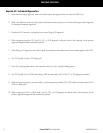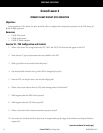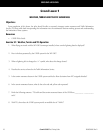
Garmin G1000 Pilot’s Training Guide
190-00368-00 Rev. D
22
APPENDIX
While managing frequencies for ground-based navaids is important, proper use of the GPS flight plan function can also prove
beneficial. Rather than performing continuous direct-to navigation with the GPS, taking the time on the ground to enter a full
flight plan allows the G1000 to enhance the navigation experience. First, the pilot will be able to visually inspect the route of
flight on the MFD map, once at altitude, so as to verify both terrain clearance (using the terrain awareness overlay) and active
airspaces (if active, MOAs and Restricted areas would call for a re-routing from ARTCC). Secondly, using the flight plan function
allows for seamless autopilot turn anticipation. Finally, taking a moment to program the flight plan on the ground makes it easier
to react quickly to in-flight routing changes. Pilots should program the flight plan on even short cross-country flights.
Likewise, the maps on both the Multi Function Display (MFD) and the Primary Flight Display (PFD) help the pilot to manage
the navigation functions of the system. By using the maps to verify GPS navigation inputs, the pilot is able to visually cross-check
data entry by looking at the course lines drawn on the map. This visual representation of the active navigation is the quickest
way to determine whether all of the correct waypoints were entered for the intended route of flight.
In this discussion so far, the focus has been on SRM. Now, attention will be turned to leveraging the various data inputs
from the on-board weather sensors, datalinks, traffic awareness and terrain awareness functions. Proper understanding of both
the operation of these various tools and their integration with the pilot’s aeronautical decision making (ADM) process can bring
significant safety gains to the GA fleet.
Weather datalink and airborne lightning detection equipment have brought unprecedented weather avoidance capabilities to
the GA aircraft. While these weather tools provide valuable information, they do have limitations that must be considered and
they should thus be used appropriately by the pilot in the ADM process.
The primary limitation with both datalink weather and airborne lightning detection equipment is that neither device is to
be used for storm penetration. Instead, these planning tools should be used to help the pilot make a timely and well-informed
decision on how to proceed with the flight. Indeed, datalink weather receivers can bring a wide variety of information into the
cockpit besides the well-known Nexrad radar images.
While avoiding strong thunderstorms and other areas of heavy precipitation is desirable, the ability to also review textual
weather information for enroute and destination allows the pilot to maintain better situational awareness for airport selection in
case of an emergency. The capability to review textual weather data from ground reporting stations while enroute also allows
the pilot to evaluate all approach options based on ceilings at the destination airport and to decide whether a diversion should
instead be made to an alternate airport much earlier in the flight. This, coupled with the ability to review weather information
well outside of the transmission range of ATIS/AWOS/ASOS systems, enables the pilot to better prepare for arrival and reduces
last-minute workload.
Thunderstorms are typically used as the main selling point for datalink weather receivers due to their visual Nexrad presenta-
tion, whereas ice – the other main weather concern for flight – is often not emphasized enough. However, it should be stressed
that the potential for icing is also provided textually and in some cases, graphically, via datalink weather. This becomes a very
powerful tool in the winter months. The ability to bring more information about the icing potential in either format type (textual
or graphical) is a significant improvement to the overall safety of flight.
1
Overlaying both the Nexrad and lightning images on either the G1000 MFD or PFD map inset serves to corroborate informa-
tion on the location of the strongest storms. When lightning detection equipment is installed in the aircraft, the unique strike-ag-
ing capability of the G1000 provides additional visual cues as to the current state/stage of the storm. Indeed, continuously grow-
ing strike rate counts as well as an increase in the number of lightning bolts (bold or normal) often denotes a developing severe
thunderstorm. On the other hand, decreasing strike rates combined with a growing number of “plus” (+) symbols indicates a
decrease in the strength of the storm and its possible dissipation.
2
While this type of information is very powerful and convincing, it is important to use it to plan the flight path and not to try
to penetrate an area of weather. Indeed, the data should be used to plan a deviation well clear of the storm in order to ensure that
the remainder of the flight can be safely executed. One should always remember that discretion is often the better part of valor
and that no technology can depict actual meteorological conditions with 100% accuracy.


















